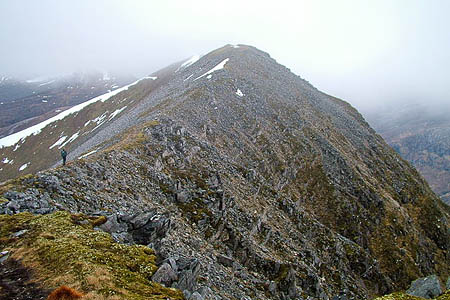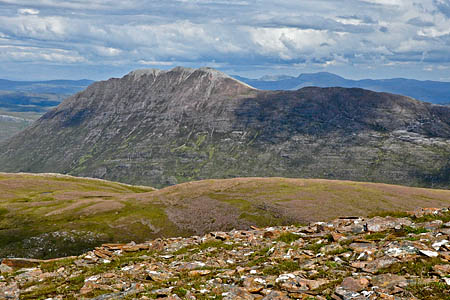One of the more curious uncertainties in recent Scottish hill history has been resolved with news that the Scottish Mountaineering Club has announced a change in the status of Beinn a’Chlaidheimh, an impressive rocky hill which rises above Strath na Sealga in Wester Ross and has long formed part of the celebrated ‘Fisherfield Six’ munros.
“Beinn a’Chlaidheimh is now a corbett,” the SMC’s publications convenor, Rab Anderson, confirmed today. “In due course the SMC will amend its books The Munros and The Corbetts to reflect this, and will amend Munro’s Tables.”
Beinn a’Chlaidheimh has been a corbett before. It began life in hill-category terms as part of John Rooke Corbett’s list of Scottish hills between 2,500ft and 3,000ft (762m and 914m), when it was listed somewhat imprecisely as “2,960+ feet”, but publication of much-improved maps of the area around 40 years ago saw its height nudge above the 3,000ft mark.
The hill was included in the SMC’s 1974 edition of Hugh Munro’s list of Scottish hills of 3,000ft or more, and formed part of the senior category from then on.
It was always regarded as borderline, however, and the summer of 2011 saw a visit by a “heighting” team from the Munro Society – an entirely separate entity from the SMC.
Munro Society enthusiasts have taken to using differential GPS gadgetry to assess whether any height changes ought to be made to various hills mapped as either just below or just above the 3,000ft (914.4m) mark.
Generally the categorisations have remained the same, for instance with Beinn Dearg in Torridon and Foinaven in the far north staying as high Corbetts during a 2007 survey.
Most of the readings have come in slightly lower, so while this has prompted some fine-tuning of established Ordnance Survey heights, it hasn’t led to a wholesale switching of allegiance in hill-list terms.
The first exception came in 2009, when Sgurr nan Ceannaichean above Glen Carron was resurveyed as 913m rather than the mapped 915m. The professionals at the OS confirmed the findings by the Munro Society amateurs, the SMC concurred and Sgurr nan Ceannaichean duly reverted to being a corbett, having travelled the other way in the late 1970s.
Things didn’t run quite so smoothly in 2011, however.
The Munro Society argued that despite being mapped as 916m, the summit of Beinn a’Chlaidheimh was actually 913 metres and 96 centimetres above sea level – which, if true, meant that it failed to reach munro height by 44 centimetres.
The society’s surveyors include a 10cm margin for error on their instrumentation, so the effective margin of change was 34cm, or just over one foot. The expectation – from within the Munro Society heighting group at least – was that the SMC would quickly accept this and the hill would, like Sgurr nan Ceannaichean before it, change status.
Except this didn’t happen, and a year-long state of limbo ensued, during which Beinn a’Chlaidheimh remained a munro but with a considerable number of people believing there to be proof that it wasn’t high enough.
During this period, the SMC’s only public comment about their reasons for not making the change came in a website statement in which they pointed out ‘the marginality of these measurements’ and said they had ‘undertaken to consider the implications’.
The statement ended thus: “We need hardly add that anyone who walks the mountains and hills of Scotland out of a love for their ambience will continue to appreciate this fine mountain, whether it be classified as a munro or a corbett.
“For the moment at least, Beinn a’Chlaidheimh remains in Munro’s Tables.”
A key moment then arrived when the OS put the new height on a map.
Ironically, this was shown as 914m, the same height credited to Beinn a’Chlaidheimh in the munro list from 1981 to 1997.
Due to rounding and imperial-to-metric conversion, 914m can be either above or below 3,000ft, but this recent OS change is clearly a rounding-up of the 913.96m figure and indicated a belief that the hill is below the magic mark.
Traditionally the SMC follows the lead of the OS with regard to hill heights, but time continued to pass without any announcement and the natives – well, the Munro Society heighting enthusiasts and hill-forum chatterers at least – started to become restless.
Eventually it was an intervention by an outside agency which led to the issue being clarified.
When the Doune-based independent mapping company Harvey Maps started work on a new edition of their popular wallchart showing the location of all munros and corbetts, they needed to know whether to portray Beinn a’Chlaidheimh using a red triangle, meaning it was a munro, or an orange triangle, meaning a corbett.
So they asked the SMC – and the response came that the hill should be shown as a corbett.
When asked today if this definitely meant that the hill had switched categories, and that there are now only 282 rather than 283 munros, the SMC’s Rab Anderson confirmed this. “To be clear,” he said, “Beinn a’Chlaidheimh was re-measured by a team of independent surveyors.
“The OS accepted the height data from this team of surveyors, the equipment used and the methodology. The SMC waited to see whether the OS would amend their maps.
“The OS duly amended their maps to show the new height of Beinn a’Chlaidheimh as being 914m. Since the SMC uses OS height data and 914.4m is the metric equivalent of 3000ft, then the SMC accepts that at 914m Beinn a’Chlaidheimh can no longer be classed as a munro.
“Accordingly Beinn a’Chlaidheimh is now a corbett.”
As might be expected, the news has been welcomed by the Munro Society. “Sir Hugh was in the process of amending his tables in the light of the information available at the time of his death,” said the society’s vice president Peter Willimott. “Well done the SMC for continuing his work and ensuring the tables continue to reflect the most accurate measurements available.”


RDS
07 September 2012Cant help feeling slightly wistful about this; the "Fisherfield Six" had a dramatic ring to it and (having done it) I cna confirm it was a fair old challenge. Fisherfield Five has a nice alliterative ring to it but ... ach, maybe its just nostalgia.
Charles Britten
14 September 2012About time too - having been in touch with both the Munro Society and the SMC it was clear last year they were not talking to each other. The Munro Society were left wondering if the SMC wanted to do their own survey, while the SMC waited for the Ordnance Survey to confirm the height.
So some of us have known for a while this demotion was going to happen. The delay seems to me to have been quite unnecessary.
Robert Hector MacDonald.
20 September 2012A very fair & balanced statement of the facts, I'd hardly expect anything else from such a reputable journalist. to me tho' it all seems rather silly that grown men are throwing their teddies out when all that is at stake is an inch and half. Then again maybe I am rather naive & don't understand the earth shaking issues that are at stake. I am glad tho' that hills aren't as contrary as folk, at least with hills one knows where one stands.
Mal Creasey
20 September 2012It's still a fine hill with wonderful views...a few centimetres really shouldn't make a ha'p'orth of difference..
Mal
Dugswell2
22 September 2012The Fisherfield Six will always live on as these mountains are all still Marilyns with a prominence of 150 meters or more.
Brian Dick
27 June 2013One less to do on the current 5th round, down from71 to 70 to complete!
Brian Dick(no364) 27/06/2013
Brian Dick
27 June 2013B Dick should be 4th round not 5th. Way ahead of myself as usual!!!
Phil Edgs
27 July 2018I would never climb this small mountain, it is tiny and worthless.